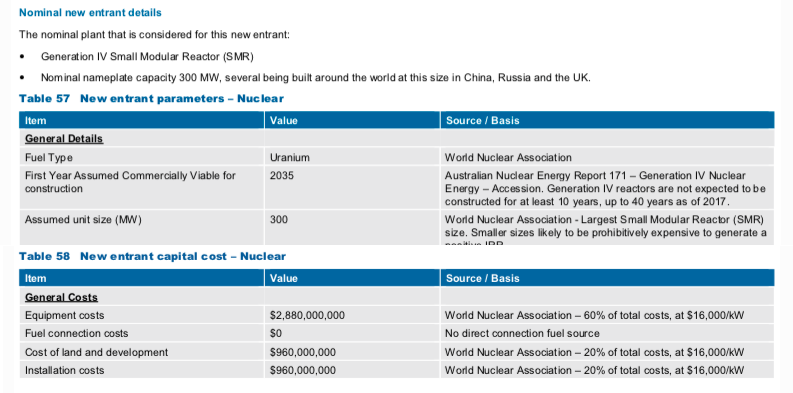Energy transition requires politicians engage with the facts.
- WePlanet Australia

- May 15, 2023
- 3 min read
Updated: Mar 25, 2024
RePlanet Australia respects that political parties have official positions, and elected representatives have personal opinions. But when bad maths, vague cherrypicking, and propaganda are presented as fact, we will correct the record.
This past weekend the Minister for Climate and Energy tweeted this. Allow us to respond.
Cost
The regionalised cost for future nuclear energy projects in Australia is so uncertain that in 2021 numerous proponent stakeholders called for its exclusion from future work by the CSIRO.
The poor results from assuming an absurdly high overnight capital cost per kilowatt of $16,000 have diminished many years of energy transition planning. In the case in hand, the magnitude of the error cannot be understated.
The original engineering firm reference for this number was supplied to the CSIRO in this table (truncated for clarity):

This $16,000/kW has apparently been multiplied by 300 MW — the capacity of the light water reactor SMR featured in this analysis, the one planned in Ontario — to arrive at $4.8 billion, and rounded up.
Delay
This time next year, Australia's trading partner South Korea will commission its next full-scale advanced nuclear plant, Unit 5 at Shin Kori, which began construction in 2017.
It's the same design as at the almost complete Barakah power plant in the United Arab Emirates — a nation that only started its program in 2008.
Countries with operational workforces and supply chains provide the counter examples to blanket dismissal of nuclear project punctuality. We're witnessing this with reactor refurbishments in Ontario, Canada, also where the first American SMR design was selected in 2021 and is on track to be operational in 2028.
Waste
In 1977, the American Physical Society study group on nuclear fuel cycles and waste management reported:
For all LWR fuel cycle options, safe and reliable management of nuclear waste and control of radioactive effluents can be accomplished with technologies that either exist or involve straightforward extension of existing capabilities.
That was almost fifty years ago but opponents of nuclear energy still insist there's no safe solution.
This management is already becoming reality in nations such as Finland, Sweden and France, as willing host communities have decided to be involved on the basis of knowledge-led consultation.
But half a century has delivered even better options, as RePlanet already advocates for. The technology to reduce the necessary time for securely managing used fuel down to a few hundred years just needs to be commercialised and deployed.
And the reduced volumes can be immobilised in Australia’s very own waste solution, SYNROC. That’s right — we have a solution before we even have nuclear power.
Where
The rhetorical question of siting.
Let's cut out all the games and be entirely honest with ourselves and each other here. The intention of this challenge is to get no answer, thereby demonstrating that no nuclear energy proponents are willing to risk the perceived political consequences. The anti-nuclear challenger's assumption is that overwhelming anti-nuclear sentiment in any given electorate would spell doom at the next poll.
The funny thing is, the assumption has already kind of been tested. In 2019 the Member for New England all but offered "his backyard" as a project site. He was returned to office last year. And during South Australia's Nuclear Fuel Cycle Royal Commission, one Senator outlined an audacious plan to pursue a fleet of advanced reactors running on recycled nuclear fuel which partner nations would pay us to take. The overwhelming majority of Adelaide readers apparently approved. And the underlying idea was even written up and published.

At the end of the day, the question makes less and less sense, as existing energy infrastructure increasingly faces local opposition. From solar farms in SA, Victoria and NSW to wind development in Queensland, and new major transmission links, "announce and defend" for any project at all isn't as viable as it once was. Note that no such locations were picked by politicians, so singling out potential nuclear projects this way is obviously inconsistent.
The alternative? When SMR Nuclear Australia publicly invited communities to volunteer potential locations:
"...about ten community groups and others had expressed interest... in hosting such a reactor, should the ban in Australia be lifted."
The energy transition has the potential to cause friction with communities as sites which historically have had little or no energy infrastructure begin to see developments. We know that the transition is vital to addressing climate change, so politicians should be offering incentives rather than barriers.
Food for thought – for all energy project proponents.
Today as the Senate Environment and Communications Legislation Committee hears from experts on nuclear energy, we encourage them to engage with the facts and remember that as political leaders they are responsible for whether our energy transition fails or succeeds.
You can watch the Senate hearing here.
See the 7 reasons why we think you should rethink nuclear as part of the clean energy transition:









